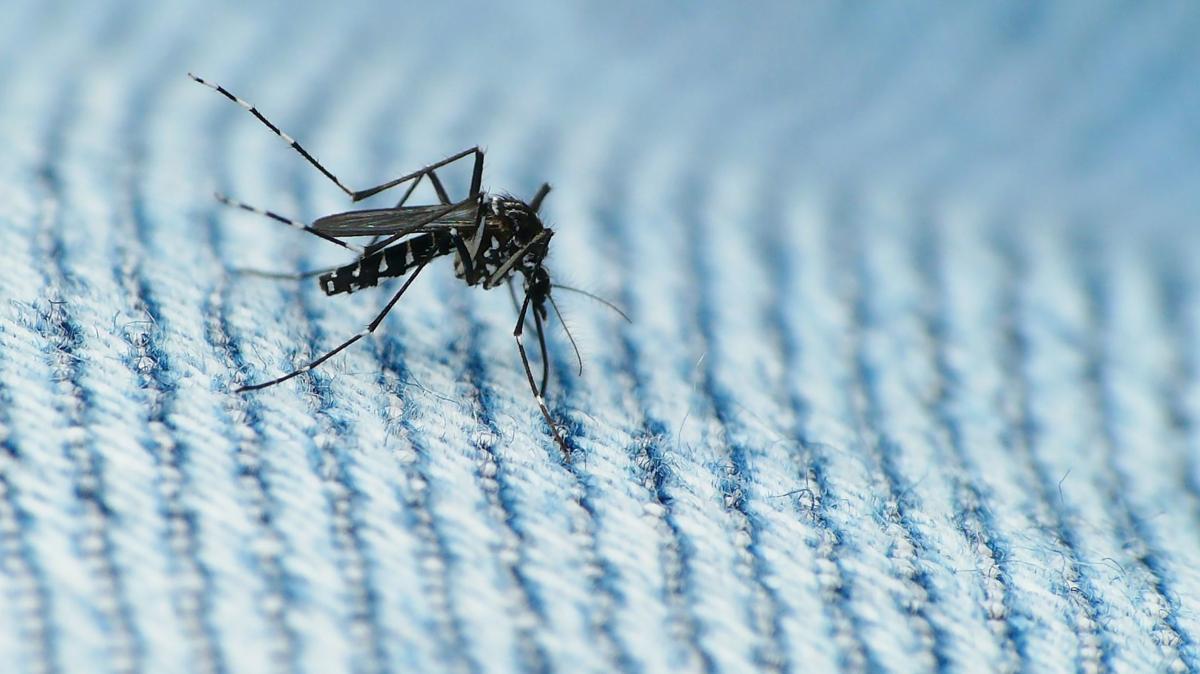Mosquito team student fellow Delilah Sayer prepares to sift mosquito larvae from breeding buckets on Wednesday, June 26, 2019, at Tyson Research Center. The students, studying under Principal Investigator Kim A. Medley, PhD, are studying how climate change influences mosquitoes able to transmit diseases that affect humans. Back row from left, student Lexie Beckermann, Adnan Shaik and Lois Mack Morrow. Photo by Laurie Skrivan, lskrivan@post-dispatch.com
Jul 7, 2019
Mosquitoes are out in force across St. Louis, but some species pose bigger risks than others
By Bryce Gray
ST. LOUIS COUNTY — Heavy rains and flooding in recent weeks mean more mosquitoes will be swarming in the St. Louis region this summer. But while nearly all mosquito species are annoying, they’re not all created equal.
Washington University researchers say the ones that lay their eggs in floodwater are unlikely to be carriers of major diseases, such as West Nile virus and dengue fever.
The same can’t be said for the now-dominant mosquito species in urban St. Louis — even though the risk is low.
“If you go out and get bit in St. Louis from dawn to dusk, it’s probably an Asian tiger mosquito,” said Katie Westby, a postdoctoral research associate at Washington U., who helps lead mosquito research from the school’s Tyson Research Center, near Eureka.
As its name suggests, the Asian tiger mosquito is an invasive outsider. The relative newcomer arrived in the U.S. in 1985 with a shipment of used car tires from Japan to Houston, says Kim Medley, director of Washington U.’s Tyson Research Center, and a leader of its mosquito research efforts. By the next year, she says, it was found in St. Louis and is now the prevailing species in the city.
Medley and Westby focus their research on the species and other types of “container-breeding” mosquitoes, which lay eggs in places that range from natural cavities in trees or rocks to water pooled in old car tires or plastic refuse.
The university researchers want to learn how these mosquitoes are affected by invasive competitors and increases in temperature wrought by climate change. Because the mosquitoes are potential vectors for a number of pathogens, ranging from Zika virus in certain conditions to dog heartworm, the researchers say an understanding of how the species respond to such ecological changes could have important applications for public health.
“These are the ones … that carry disease or pathogens of human importance,” Medley said.
Both Medley and Westby emphasize that their work is not the same as determining public health risks from mosquitoes now or in the future — something that is left to experts in other fields. They are also careful when describing the level of risk that container-breeding mosquitoes present for transmitting disease to humans.
“The possibility is there, but I don’t think the risk is high,” said Westby. Still, she warns that it’s important to keep tabs on species as prevalent as the Asian tiger mosquito. “The potential is so large that they are an important species to monitor.”
Washington U.’s mosquito research is especially relevant as climate change rapidly ushers in new environmental conditions.
“With climate change and vector-borne disease, it’s something people have been concerned about for a very long time,” Westby said.
To see what those changes could mean locally for certain container-breeding mosquitoes, one of Medley and Westby’s experiments looks at how the native eastern tree hole mosquito and another invasive, the Asian rock pool mosquito, fare against one another at different temperature settings. Off in the woods at Tyson, they keep some buckets filled with water and mosquito larvae at the ambient temperature, while others are kept warmer by 3 degrees Celsius — an average temperature difference Medley said is a “relatively realistic level for this region” to expect over the next few decades.
This year’s trial is ongoing, but last summer, they found that the Asian rock pool mosquito was less abundant in the warm buckets, while the temperature change did not affect its native competitor.
Native species don’t always do so well in comparison. Separate experiments done by Medley’s lab show that the eggs and larvae of the Asian tiger mosquito are able to out-compete other container-breeding mosquito species, particularly in dense urban settings of St. Louis.
The lab also does some separate but similar work that looks at ticks, which, in recent years, have been a more common vector than mosquitoes for transmitting disease to humans, according to the Centers for Disease Control and Prevention’s analysis of the “growing burden of mosquito-borne and tickborne illnesses in the U.S.”
Other studies — including one published in Nature last month — have detailed looming threats from mosquito-borne illness because of climate change. That study found that climate change and urbanization are expected to fuel expansion of the global range of dengue fever in the coming decades. Much of the Southeast U.S., for instance, “is predicted to become suitable by 2050,” the authors wrote.
“I’m always waiting for them to cause a major outbreak (of disease), but it doesn’t happen often,” said Westby. A recent example occurred in India when mosquitoes triggered an outbreak of chikungunya virus, she and Medley said. That virus can cause severe and disabling joint pain and fever, the CDC says.
Those outbreaks could be so rare because transmitting disease is so complex — hinging on wide-ranging factors, right down to the sequence of a mosquito’s chain of blood meals.
Westby and Medley are therefore hesitant to venture their own outlooks for the future, and instead stress the importance of continued research and vigilance.
“These pathogen-host interactions are so complex overall and across species,” Medley said. “It’s really hard to predict what’s going to happen.”
The Asian tiger mosquito, or Aedes albopictus, seen here in 2008 photo. (Photo by coniferconifer via Flickr Creative Commons license)


